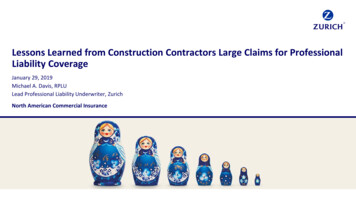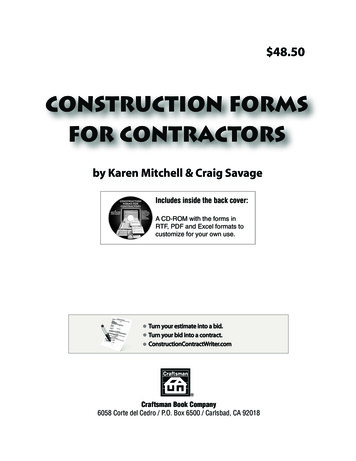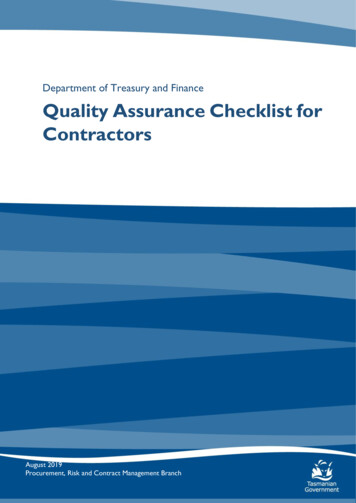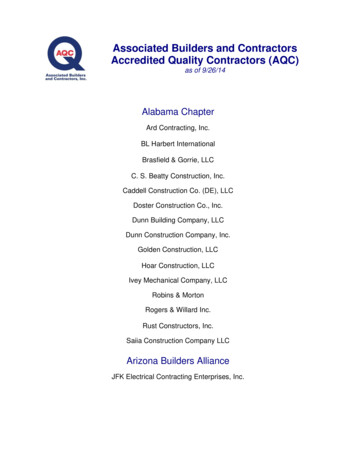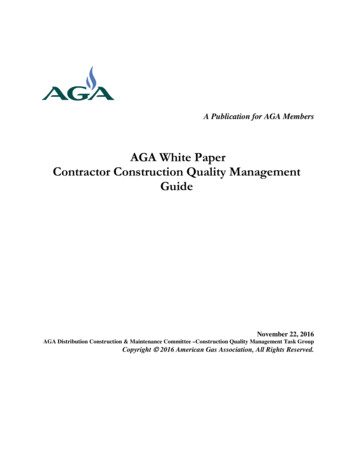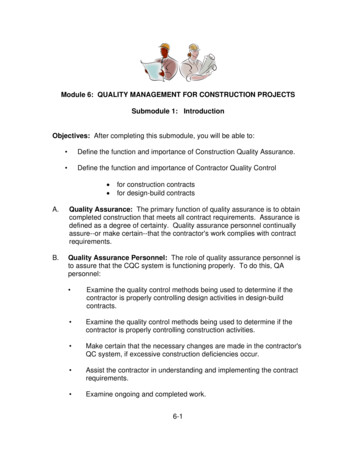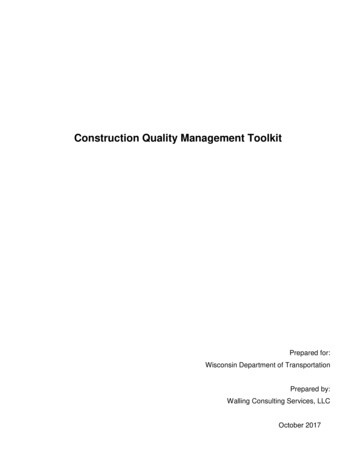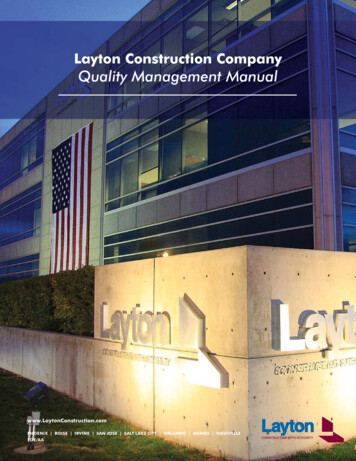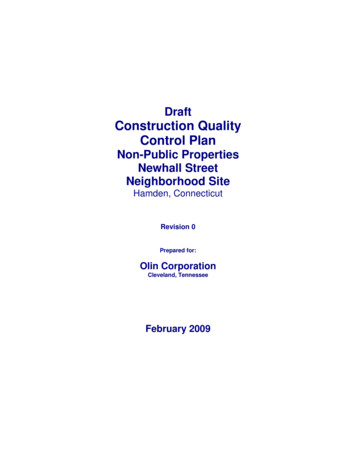
Transcription
Control #784Revised 2004CONSTRUCTION QUALITYMANAGEMENTFOR CONTRACTORSStudent Study GuideProduced By:U.S. Army Corps of EngineersProfessional Development Support Centerand U.S. Naval Facilities Engineering Command (NAVFAC)
CONSTRUCTION QUALITY MANAGEMENT FOR CONTRACTORSSTUDENT STUDY GUIDETABLE OF CONTENTSPageModule 1. Introduction . 1-1Submodule 1 What is Construction Quality Management (CQM). 1-1Objectives. 1-1A. Introduction and Instructional Procedures . 1-1B. Instructional Content. 1-2C. History of Construction Quality Management . 1-2D. Construction Quality Management. 1-3E. Contractor Quality Control . 1-3F. Government Quality Assurance . 1-3G. The Corps' and NAVFAC's CQM System . 1-3H. The Benefits of CQM . 1-4I. Characteristics of the Construction Industry . 1-4J. In The Future . 1-5K. Conclusion . 1-6Exercise. 1-7Table 1.1-1 Components of CQC . 1-9Submodule 2. Contractor Quality Control . 1-13Objectives. 1-13A. Control Versus Inspection. 1-13B. Responsibilities. 1-13C. Benefits to the Contractor . 1-14D. Benefits to the Government . 1-14E. Benefits to the Client/Customer . 1-15F. Presenting The Program. 1-15Exercise. 1-16Submodule 3. Contractor and Government Responsibilities . 1-19Objectives. 1-19A. Quality Control Personnel . 1-19B. The Government. 1-20C. Communications . 1-20D. Partnering . 1-20E. Summary . 1-21Exercise. 1-22i
Module 2. Contractor's Review . 2-1Objectives. 2-1A. Review Plans and Specifications . 2-1B. RFI Process . 2-2C. Contractor Furnished Designs . 2-2D. Value Engineering Change Proposal (VECP). 2-2E. Design-Build . 2-3Exercise. 2-4Module 3. Quality Management Planning . 3-1Submodule 1. Purpose and Components. 3-1Objectives. 3-1A. The Quality Assurance Plan . 3-1B. The Quality Control Plan. 3-2C. Quality Control Plan Components. 3-2D. References . 3-6Exercise. 3-7Submodule 2. Review and Acceptance. 3-11Objectives . 3-11A. Quality Control Plan Review Participants . 3-11B. Two Major Steps in the Review Process . 3-11C. Assure Minimum Requirements Are Met . 3-11D. Acceptance of the QC Plan . 3-12E. Commencement of Construction . 3-12F. Changes to the QC Plan. 3-12G. Distribution. 3-12H. Example Quality Control Plan . 3-13Exercise. 3-14Example Quality Control Plan. 3-15Module 4. Post-Award Orientation/Preconstruction Conferences and theCoordination Meeting (Mutual UnderstandingMeeting - Navy). 4-1Objectives. 4-1A. General. 4-1B. The Post-award Orientation Conference/Preconstruction Conference . 4-1C. The Preconstruction Safety Conference . 4-2ii
D. The Coordination and Mutual UnderstandingMeeting (Navy) . 4-2E. QC Plan Meeting . 4-3Exercise . 4-4Sample Coordination Meeting or the MutualUnderstanding Meeting (Navy) Agenda. 4-6Module 5. Submittals . 5-1Objectives. 5-1A. General. 5-1B. Purpose . 5-2C. Contractor Submittal Responsibilities . 5-2D. Government Submittal Responsibilities . 5-3E. Controlling and Scheduling . 5-4Exercise. 5-5Module 6. Quality Management For Construction Projects. 6-1Submodule 1. Introduction. 6-1Objectives. 6-1A. Quality Assurance. 6-1B. Quality Assurance Personnel. 6-1C. Contractor Quality Control . 6-2D. Quality Control Personnel . 6-2Exercise. 6-3Submodule 2. Three-Phase Control System . 6-7Objectives. 6-7A. Purpose . 6-7B. The Three-Phase Control Responsibility . 6-7C. The Three-Phase Control System . 6-8D. Cautionary Note. 6-9Exercise. 6-12Practical Exercise (Preparatory Phase Meeting) . 6-13Sample Preparatory Phase Checklist . 6-15iii
Submodule 3. Documentation . 6-19Objectives . 6-19A.Quality Management Record Keeping . 6-19B.The Contractor Quality Control Report . 6-19C.The Government Quality Assurance Report . 6-21D.Deficiency Tracking System/Rework Items List . 6-21Exercise . 6-22Submodule 4. Testing. 6-28Objectives . 6-28A.Importance of Testing . 6-28B.Types of Tests . 6-28C.Procedures . 6-28D.Testing Tracking System . 6-30Exercise . 6-31Submodule 5. Completion of Work . 6-35Objectives . 6-35Quality Management Completion Procedures. 6-35Exercise . 6-37Module 7. Making the System Work . 7-1Objectives . 7-1A.Problem Categories . 7-1B.Government Options. 7-2C.Making the "System" Work . 7-4D.Quality Assurance Personnel. 7-4Exercise . 7-5Module 8. Quality Control System (QCS) and ResidentManagement System (RMS) . 8-1Submodule 1. Introduction and Overview . 8-1Objectives . 8-1A.Introduction and Background . 8-1B.Approach to Data Management . 8-6C.Benefits. 8-6D.Major CQM Output Products of QCS and RMS. 8-6E.Other QCS and RMS Features . 8-7Exercise . 8-8iv
Submodule 2 Quality Control Components. 8-11Objective . 8-11A.Preparatory and Initial Phase MeetingAgendas and "Check" Databases. 8-11B.Submittal Process in QCS and RMS . 8-12C.QC /QA Deficiency Tracking System . 8-12D.Summary . 8-12Exercise . 8-13Module 9: NAVFAC's Web-Based Construction Management System(WebCM) . 9-1Objectives . 9-1A.Introduction . 9-1B.WEBCM Functionality. 9-1C.Benefits of Using WebCM. 9-3D.Major CQM Output Products of WebCM. 9-4E.Summary . 9-4Exercise . 9-5List of Acronyms . R-1References . R-4Forms:Corps . R-6Navy . R-10Navy QC Plan. R-27Exercise Answer Key . K-1v
Unless otherwise noted, the words, "he, him, or his" refer to both men andwomen.All forms used in this guide were current as of January 2004. Students shouldupdate their guides with the latest forms as they become available.
FOREWORDThis training package has been developed to help familiarize contractorpersonnel with the Construction Quality Management concepts and procedures.This guide was designed to be used as a workbook during the training program.It is intended that, after the training, it be included in your office bookshelf as ahelpful tool to be used when needed. Updated material may be issued asnecessary as errata sheets.Questions pertaining to interpretation and explanation of this guide andsuggestions for revisions and improvements should be forwarded to:USACE Professional DevelopmentSupport CenterATTN: CEHR-P-DLP.O. Box 1600Huntsville, AL 35807-4301
Module 1: INTRODUCTIONSubmodule 1: What is Construction Quality Management (CQM)?"PROACTIVE PREVENTION vs. REACTIVE INSPECTION"Objectives: After completing this submodule, you will be able to: State the purpose of Construction Quality Management. Discuss the reasoning behind the Corps/NAVFAC policy on CQM. Discuss various characteristics that are peculiar to the constructionindustry. Define Contractor Quality Control (CQC).Define Government Quality Assurance (QA).A.Introduction and Instructional Procedures:This training is presented as a result of partnering efforts with theAssociated Builders and Contractors (ABC), Associated GeneralContractors (AGC), the U.S. Army Corps of Engineers (USACE), and theNaval Facilities Engineering Command (NAVFAC). This is appropriate asConstruction Quality Management is a partnering effort between theGovernment and the contractor. The purpose of this training is to familiarizeall quality control personnel, and other contractor management personnel,with CQM policies, requirements, and procedures. In addition
Contractors (AGC), the U.S. Army Corps of Engineers (USACE), and the Naval Facilities Engineering Command (NAVFAC). This is appropriate as Construction Quality Management is a partnering effort between the Government and the contractor. The purpose of this training is to familiarize
